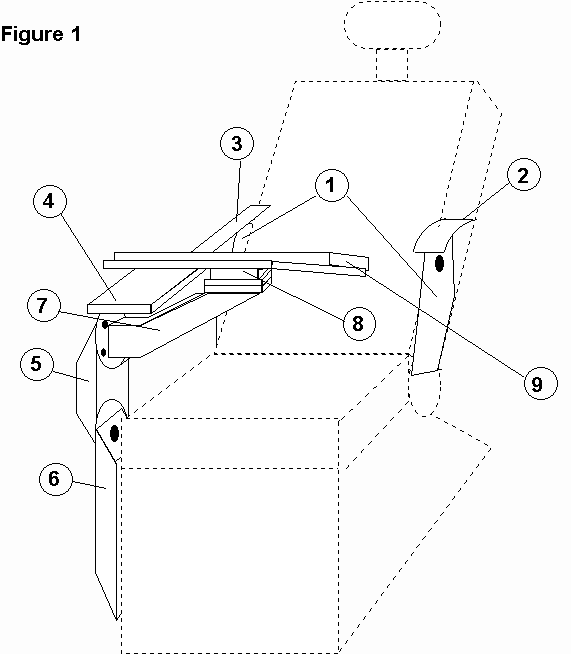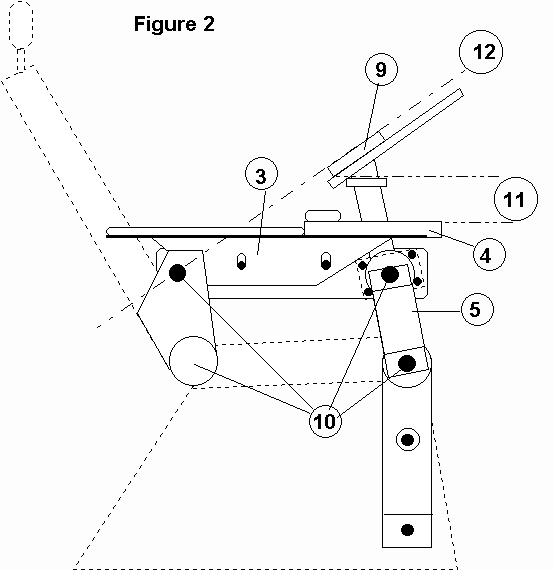
1
COMPUTER CHAIR
This invention, when incorporated into an adjustable reclining chair, supports a computer keyboard and other hand-operated input device, e.g. ďmouseď or joystick, in positions which allow use with a minimum of discomfort.
Most chairs in current use for computer work are swivel based Ďtaskí chairs used to address computer equipment mounted on a flat horizontal desk. These are designed to encourage an upright posture and give minimal support to the upper body which leads to four groups of problems.
Loadings on the muscles of the spine which cannot be sustained for long periods and result in back and neck aches and longer term back problems.
The necessary position and orientation of the eyes restrict the positioning of the computer screen leading to a conflict between the most relaxed viewing position and loss of contrast through reflections from ceiling lights. This causes headaches and other symptoms of eyestrain.
It is possible with discipline to achieve a good presentation to the keyboard and mouse with straight unloaded wrists. However after a period of work, attempts to alleviate problem 1 by changing position result in load being transferred to the arms, the wrists becoming angled and stressed, which if sustained can lead to such conditions as carpal tunnel syndrome or tennis elbow.
The entire weight of the operator rests upon his or her buttocks. This restrict blood circulation, leading to numbness and discomfort, and occludes skin in the cleft leading to anal itching or haemorrhoids which can become persistent., or even thromboses. It is not possible to alleviate this by changing position unless the seat is very hard and uncomfortable.
This invention solves these problems by providing a mechanism for supporting a computer keyboard and/or other manual computer input device on a reclining chair suitable for long term use, comprising a horizontal member (the arm) and a member parallel to the chair back (the link), connected to each other and to the chair by pivots in a parallelogram arrangement so that the arm remains horizontal and the input devices remain conveniently positioned for use as the chairís angle of recline is changed.
The moving members are connected by pivots to brackets which are rigidly attached to the chair back and base. The front lower pivot is on a level with the seat back hinge. and set forward from it by a distance equal to the length between the pivot points of the arm.
A small horizontal table (the table) may be mounted on the arm to support a mouse pad or other input device. A cantilever from the arm (the cantilever) may support a keyboard centrally in front of the user. The cantilever and arm may be constructed in parts to allow reassembly to either side of the chair.
The armrest(s) may be fitted with vertical adjustment to accommodate the userís elbow height. A means of adjustment of keyboard inclination to suit user preference may be provided. At the shallowest angle the plane of the keys should pass through the armís rear pivot.
A wrist support may be provided on the table.
The keyboard may be mounted on the cantilever using detachable hook-and-loop strips. This or other means may be used to adjust the keyboard position in order to accommodate the userís forearm length. The cantilever may also carry a document stand.
The front bracket, link and cantilever should be of substantial construction, for example box-section steel, to minimise keyboard vibration.
Access to the chair is from the side, the opposite armrest being moveable, reduced or omitted.
2
An embodiment of the invention will now be described with reference to the accompanying drawings in which:
FIGURE 1 shows a view of the whole chair.
FIGURE 2 shows the arrangement of arm components and the keyboard angle and height.
This embodiment is based on a chair with a tubular steel frame such as is found in commercial vehicles.
It is described for right-handed users, but can be assembled reversed for left handed users.
Flat parallel sheet steel brackets (1) with a hole near the top are welded to the chair back on each side, just above the hinge. On the left side a short cushioned elbow rest (2) is bolted to the top of the bracket. Its mounting hole is slotted to allow height adjustment.
On the right side a full length arm (3) is attached to the bracket by a pivot. The arm is made of two components bolted together with slotted holes to allow for elbow height adjustment.
The upper component has a tee section. A table (4) with a wrist support cushion is mounted on the distal end to carry a mouse pad, joystick or other input device. The remainder is cushioned on top to form an armrest. The lower component is flat and vertical and has holes at both ends for pivots and at the distal end for mounting the keyboard cantilever. The arrangement of these holes determines the inclination of the crank of the cantilever toward the user.
A link (5) of box section construction with holes at both ends has its upper end connected to the outboard side of the armís distal pivot. The length between its pivot holes is equal to the distance between the rear bracket hole and the chair back hinge. The pivots are of large diameter, at least 8cm, to resist the twisting moment of the keyboard arm, and the moving surfaces are separated by a plastic washer.
A vertical bracket (6) of box section construction with a hole at the top is rigidly attached to the chair base so that the hole is level with the chair back hinge and its distance from the hinge line is equal to the length between the pivot holes in the arm. The lower hole of the link (5) is attached to the bracket by a pivot similar to the upper one.
The four pivot points (10) are so arranged to form a horizontal parallelogram.
A cranked box-section steel arm (7) with flanges welded at both ends supports the keyboard centrally in front of the user at a suitable height as described below. The outer flange is vertical and surrounds the front upper pivot The mounting holes are symmetrically disposed around the plane of the crank so as to allow left or right-handed mounting. The box section is cut away to allow access to the pivot. The inner flange is horizontal and symmetrical, when mounted its centre line lies on the centre line of the chair.
A plate and a horizontal flange to match the above are welded to the ends of a short length of box-section steel (8), and the keyboard (9) is mounted on the plate by detachable self-adhesive hook-and-loop strips. The plate is inclined (12) so that the plane of the keys passes through the rear upper pivot of the chair arm.
The keyboard support plate does not extend over the table, although a standard keyboard itself does in the right-handed assembly, and keyboard mounting height (11) must be sufficient to allow a mouse and hand to pass freely underneath, about 7cm minimum clearance is required.
1/2

2/2

ABSTRACT
COMPUTER CHAIR
An armrest for a reclining chair which supports a computer keyboard (9) and other input device, e.g. mouse (4). The mechanism is pivoted with a parallelogram action to make the positioning of the input devices relative to the user independent of the angle of recline. The components can be assembled for left- or right-handed use.
(Figure 1 to accompany abstract.)
3
CLAIMS
A mechanism for supporting a computer keyboard and/or other manual computer input device on a reclining chair comprising a horizontal member and a member parallel to the chair back connected to each other and the chair by pivots in a parallelogram arrangement so that the arm remains horizontal and the input devices remain conveniently positioned as the chairís angle of recline is changed.
A device as claimed in Claim 1 with a cantilever arm attached to the horizontal member to support a keyboard centrally in front of the user.
A device as claimed in any preceding Claim with arrangements to adjust the positions of the keyboard, input device and/or armrests to suit the user.
A device as claimed in any preceding Claim which can be re-assembled for left- or right-handed use.
A device substantially as herein described above and illustrated in the accompanying drawings.